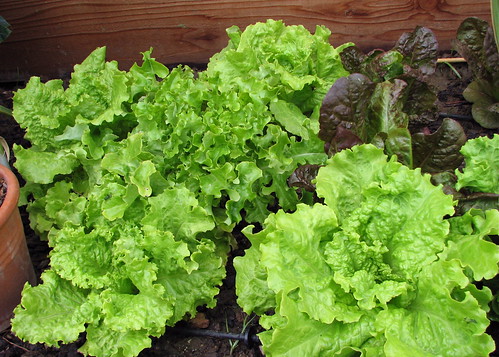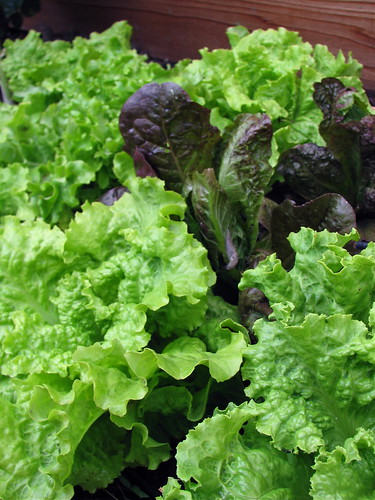It’s already May and the plants are really starting to take off. We have already started to enjoy the fresh spinach and lettuce and we are waiting for the others to catch up. Throughout the week I’m going to break down the garden in sections and talk about what’s working and what’s not.
Greens
Lettuce

What you see here is my massive crop of lettuce.
Varieties: Black Seeded Simpson, Grand Rapids, Merveille des Quartre Seasons (aka Four Seasons Lettuce)
What I have learned so far:
1. There are countless varieties of lettuce however they all fall into one of these four categories a) Leaf Lettuce (Black Seeded Simpson), b) Butterhead lettuce (Merveille Des Quartre Seasons), c) Romaine (large tall leaves), d) Crisphead (typically what you find at grocery stores).
2. Lettuce grows best in fall and spring months when the weather is cooler but there is still plenty of sunshine.
3. Leaf lettuce varieties usually take the shortest time to grow (45 days) and will grow back the leaves. (aka cut and come again).
4. In contrast butterhead lettuce takes longer and will not grow back it’s leaves. However it is beautiful to look at and are so delicious.
5. Biggest enemy : Aphids but a regular washing of the leaves with the hose have kept them contained.
Spinach
Varieties: Catalina Baby Spinach, Bloomsdale and Correnta.
What I’ve learned so far:
a) Spinach loves cooler weather and certain varieties will bolt (begin to flower) making them inedible.
b) Spinach leaves will grow back after they have been cut.
c) Baby spinach is not ideal for Zone 9 and hot weather. I could not get a sustainable crop from this variety.
d) Spinach seeds have a short shelf life and my seeds from last year did not yield any plants.
e)Biggest Enemy: Snails since the leaves lie flat they are easy prey for slugs and snails.
Chard
Chard is a mystery plant to me as I have never eaten it. It is however very pretty to look at.
Variety: Bright Lights
What I have learned so far:
a) Chard is in from the beet family although it resembles spinach.
b) Bright Lights Chard has stems that are either bright red or yellow.
c) Young leaves can be chopped up and used in salad.
d) Adult chard leaves get quite large but have a bitter flavor. They must be cooked or steamed to remove the bitterness.
e) Enemies: A mysterious virus or insect has recently infected my chard. It was growing great but recently it has developed white colorless sections on it’s leaves.
Despite the fact that greens are really more ideal for cooler climates I highly recommend growing and experimenting with different varieties. Nothing compares to a fresh salad from your garden.

Leave a Reply to Garrett Cancel reply